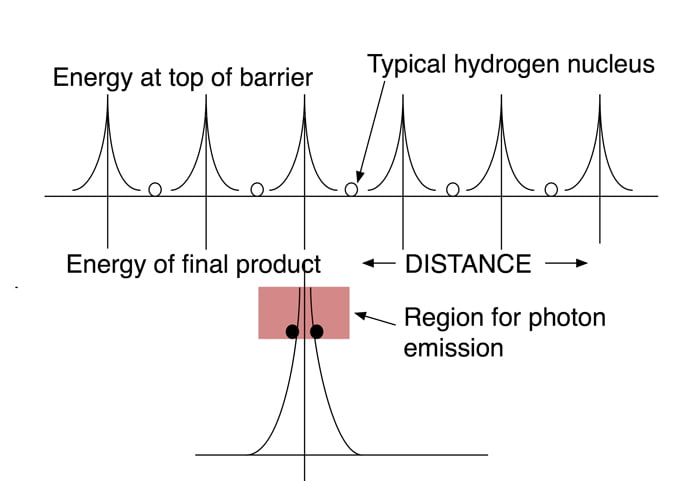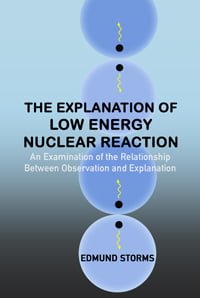Graphic: Artist rendition by Ruby Carat of Edmund Storms’ hydroton structure just before fusion.
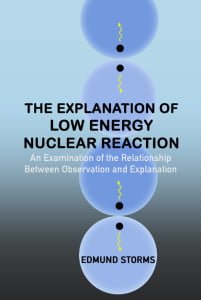 A new book by Edmund Storms reviews the top contenders for the scientific prize of the century, the theory of cold fusion, and analyzes the assumptions on which each different model rests with the critical glare of the scientific method.
A new book by Edmund Storms reviews the top contenders for the scientific prize of the century, the theory of cold fusion, and analyzes the assumptions on which each different model rests with the critical glare of the scientific method.
The Explanation of Low Energy Nuclear Reaction: An Examination of the Relationship between Observation and Explanation published by Infinite Energy Press, juxtaposes today’s theories with the observed laboratory results, and applies the basic laws of physical nature and materials science to the metallic host of the reaction.
Unsatisfied that the current explanations of cold fusion do not address the wide variety of data, and require unsupportable assumptions, Dr. Storms then offers another idea – how to initiate the reaction, essentially describing the nuclear active environment (NAE), the set of necessary and sufficient conditions needed for the reaction to occur.
Where does the reaction occur?
This is a contentious issue, as researchers in the field still do not agree on where the reaction actually occurs. Storms believes it occurs outside the chemical structure of the host metallic lattice in tiny nano-cracks that trap hydrogen nuclei and electrons in an unusual configuration. When the hydroton resonates, a form of fusion occurs whereby the mass is transformed to heat energy in smaller portions, and photons are released along the axis of the column of hydrogen. Make the right-sized space, fill it with hydrogen, apply resonance, and the reaction will happen straightaway.
His recipe was constructed from the grass roots of science – lab measurements collected over twenty-five years by a global community. In those years, Storms has conducted multiple surveys of the field, as both a Los Alamos National Lab nuclear chemist, and an independent researcher, giving him a broad familiarity with the observations.
In the book’s Foreword, Dr. Michael McKubre (SRI) writes: “The opportunity to learn directly from the most knowledgeable person in arguably the most important emerging field, and to share his concise and well considered condensation of a difficult and scattered literature, are not the only or primary reasons to comprehend The Explanation of Low Energy Nuclear Reaction. Laid out clearly and gently in Chapter 5, ‘Description of an Explanation,’ is the first physical science based description of a potential explanation for cold fusion.”
Different model for every lab
While cold fusion has been an experimental fact for two-and-a-half decades, a generally accepted theory has eluded scientists, and it hasn’t helped that the laboratory phenomenon of cold fusion is in complete disagreement with conventional nuclear theory. That, and the ragged history of reproducibility (now ended), has revealed a completely new frontier in condensed matter nuclear science (CMNS): the apparent creation of fusion-sized heat and other transmutation elements in and around metallic solids like palladium and nickel, among other materials.
It means a source of ultra-clean energy, super dense and long-lasting, decentralized and off-grid. With a virtually limitless supply of fuel from hydrogen, it means a second chance for a green technological future for the planet. As all systems re-tool to accommodate the new energy technology, it means a new economy as well. The tiny reactors are now being engineered for consumer devices, yet the pace is slow.
Each lab with a working generator follows a different model of the reaction. JET Energy has the NANOR device, engineered by Dr. Mitchell Swartz in association with theorist Dr. Peter Hagelstein of the Massachusetts Institute of Technology. The Brillouin Hot Tube is based on engineer Robert Godes‘ Quantum Fusion Theorem. Andrea Rossi‘s E-Cat was developed with the thinking that nickel-to-copper transmutations as described by Sergio Focardi provided the powerful thermal output. In Japan, Technova, Inc is associated with theorist Dr. Akito Takahashi of Kobe University, and the list goes on.
All these models have gone through revisions as new ideas arrive. Still, none of the proposed explanations have fostered the winning coup of both control of the generator and a commercially-viable energy output. Only a complete theory will describe how to maximize the potential of this reaction and point to an optimally engineered technology.
Soliciting wider participation to find a solution
From the book’s website http://lenrexplained.com/:
“The Explanation of Low Energy Nuclear Reaction: An Examination of the Relationship between Observation and Explanation attempts to bridge the gap between what is thought to be true and possible by conventional scientists and what is claimed by people advocating the reality of the cold fusion phenomenon.”
“Hopefully, the approach used in the book will help more people understand how cold fusion might function as a real phenomenon and will show how the phenomenon is now too important as a potential source of ideal clean energy for rejection to continue,” writes Storms.
Cold Fusion Now’s Ruby Carat helped to edit the book and rocked the cover with an artist’s representation of the hydroton.
 The 351-page book includes over 900 references to relevant literature and begins shipping today.
The 351-page book includes over 900 references to relevant literature and begins shipping today.
Order a copy of The Explanation of Low Energy Nuclear Reaction from Infinite Energy Press here.
Read an interview with author Edmund Storms conducted by Christy Frazier of Infinite Energy Magazine here.
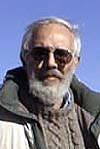 Nuclear chemist and former Los Alamos National Laboratory rocket scientist Dr. Edmund Storms has been researching cold fusion/LENR since 1989 and talks with Ruby Carat on the Cold Fusion Now! podcast about this new area of science founded by Drs. Martin Fleischmann and Stanley Pons.
Nuclear chemist and former Los Alamos National Laboratory rocket scientist Dr. Edmund Storms has been researching cold fusion/LENR since 1989 and talks with Ruby Carat on the Cold Fusion Now! podcast about this new area of science founded by Drs. Martin Fleischmann and Stanley Pons.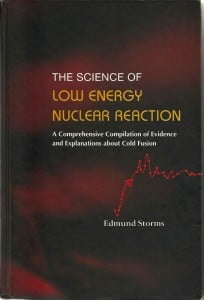 Edmund Storms has written over a hundred papers and several surveys of the condensed matter nuclear science field, including books The Science of Low Energy Nuclear Reaction, a survey of the experiments and theories of the field through 2007, and, The Explanation of Low Energy Nuclear Reaction, A Comprehensive Compilation of Evidence and Explanations about Cold Fusion, describing the top contenders for a LENR theory, as well as providing a new model of the reaction derived solely from the physical evidence.
Edmund Storms has written over a hundred papers and several surveys of the condensed matter nuclear science field, including books The Science of Low Energy Nuclear Reaction, a survey of the experiments and theories of the field through 2007, and, The Explanation of Low Energy Nuclear Reaction, A Comprehensive Compilation of Evidence and Explanations about Cold Fusion, describing the top contenders for a LENR theory, as well as providing a new model of the reaction derived solely from the physical evidence. A LENR Research Documentation Project by Thomas Grimshaw of the Energy Institute University of Texas at Austin has compiled Storms’ LENR work through 2015.
A LENR Research Documentation Project by Thomas Grimshaw of the Energy Institute University of Texas at Austin has compiled Storms’ LENR work through 2015.  Patreon is a platform for financially supporting the creative . You can pledge as little as a dollar per episode and cap your monthly spending. When we deliver, you reward the work!
Patreon is a platform for financially supporting the creative . You can pledge as little as a dollar per episode and cap your monthly spending. When we deliver, you reward the work! 

 Poster art by Tom Maguire
Poster art by Tom Maguire
